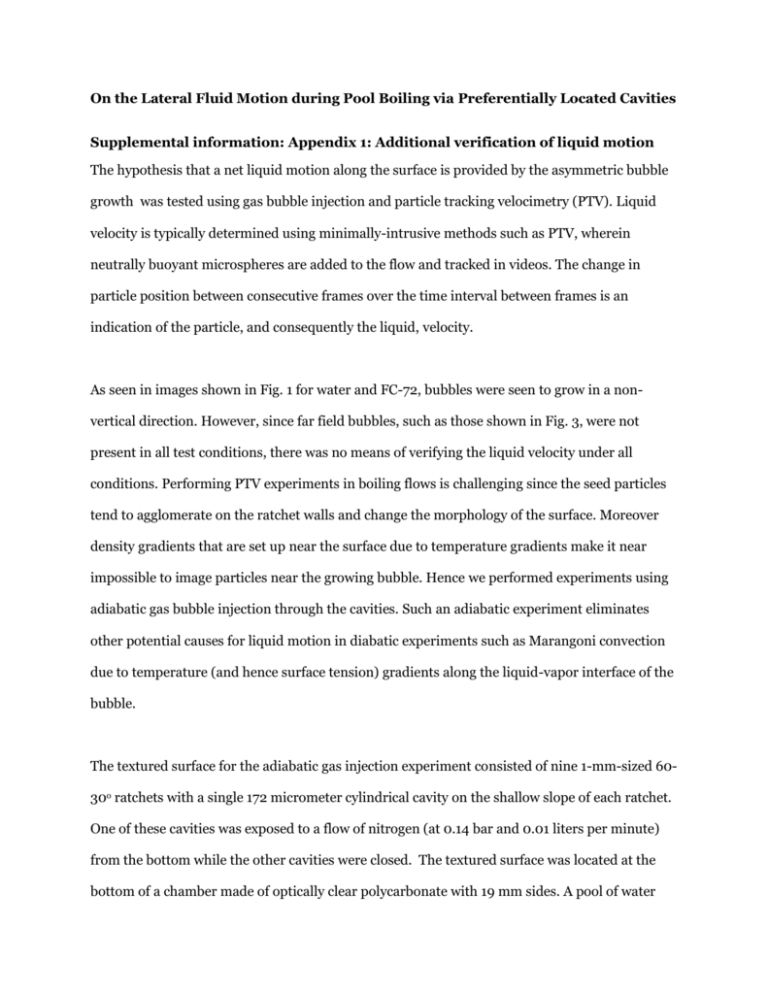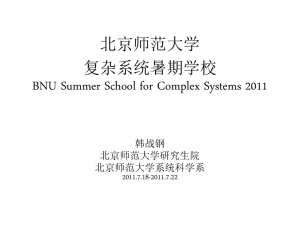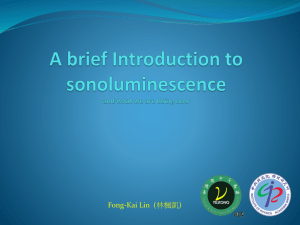APL Supplementary Materials_Kapsenberg et
advertisement

On the Lateral Fluid Motion during Pool Boiling via Preferentially Located Cavities Supplemental information: Appendix 1: Additional verification of liquid motion The hypothesis that a net liquid motion along the surface is provided by the asymmetric bubble growth was tested using gas bubble injection and particle tracking velocimetry (PTV). Liquid velocity is typically determined using minimally-intrusive methods such as PTV, wherein neutrally buoyant microspheres are added to the flow and tracked in videos. The change in particle position between consecutive frames over the time interval between frames is an indication of the particle, and consequently the liquid, velocity. As seen in images shown in Fig. 1 for water and FC-72, bubbles were seen to grow in a nonvertical direction. However, since far field bubbles, such as those shown in Fig. 3, were not present in all test conditions, there was no means of verifying the liquid velocity under all conditions. Performing PTV experiments in boiling flows is challenging since the seed particles tend to agglomerate on the ratchet walls and change the morphology of the surface. Moreover density gradients that are set up near the surface due to temperature gradients make it near impossible to image particles near the growing bubble. Hence we performed experiments using adiabatic gas bubble injection through the cavities. Such an adiabatic experiment eliminates other potential causes for liquid motion in diabatic experiments such as Marangoni convection due to temperature (and hence surface tension) gradients along the liquid-vapor interface of the bubble. The textured surface for the adiabatic gas injection experiment consisted of nine 1-mm-sized 6030o ratchets with a single 172 micrometer cylindrical cavity on the shallow slope of each ratchet. One of these cavities was exposed to a flow of nitrogen (at 0.14 bar and 0.01 liters per minute) from the bottom while the other cavities were closed. The textured surface was located at the bottom of a chamber made of optically clear polycarbonate with 19 mm sides. A pool of water 50.8 mm in height was seeded with white, polyethylene microspheres (Cospheric Inc) of diameter 53-63 m, density of 1.00 g/cm3, and coated with Tween 80. High speed videos were recorded using a shadowgraphy method by illuminating the chamber from the back side with a custom LED array. A Vision Research Phantom v310 high-speed camera fitted with a long working distance microscope objective was used to record videos at 200 frames per second and a spatial resolution of 128 pixels/mm. Bubble height and diameter were determined using image processing in Vision Assistant (National Instruments); details are provided in Strid [17]. Particle tracking is achieved through the same custom algorithm used for tracking bubbles shown in Fig. 3 [16]. Figure S1a, enhanced online, show a video sequence of processed PTV maps along with superimposed bubble profiles. The attached nitrogen bubble is seen to qualitatively exhibit the same behavior as the vapor bubbles in the diabatic test in Fig. 1. The bubble grows hemispherically and normal to the sloped surface in the initial phase. Towards the latter stage of bubble growth, buoyancy influences the direction of the growth and departure of the bubble. Once departed, coalescence of the bubbles occurs with the previously departed bubble. The PTV velocity vectors clearly indicate a directional motion from left to right as a result of the bubble growth. While the magnitude of the velocity is not of importance and can be changed by varying the injection velocity, the results indicate that, as a consequence of the bubble growth normal to the shallow face of the ratchet, the surrounding liquid is imparted a net lateral (along the surface) motion in the pool resulting in the pool circulation ( Fig. S1a). The gas injection experiment was also used to determine the area of influence (Ainf, in Eq. 3) that the bubble has on the surrounding liquid. In order to accomplish this, cylindrical areas equaling ‘n’ average bubble diameter during the growth cycle normal to the ratchet surface were isolated and the average velocity of particles (liquid) in the control volume was estimated over 800 frames (14 bubble departure cycles). Figure S1b-d represent the three control volumes of the liquid of width 1, 2 and 3 average bubble growth diameters that are oriented at the angle of the shallow ratchet face. The average velocity over 800 frames in each of the three Ainf is shown in Fig. S1e. Also shown is the horizontal and vertical component of velocities. As expected from Fig. S1b-d, the liquid velocity decreases with an increase in size of Ainf. The average liquid velocity from PTV over 14 bubble cycles was 74.98 mm/s, 57.35 mm/s and 49.76 mm/s for Ainf of 1D, 2D and 3D respectively. The average direction of the liquid flow were 32.68, 35.00, 38.69 degrees from vertical respectively for Ainf of 1D, 2D and 3D. The predicted liquid velocity using Eq. 3 is also shown as a comparison in Fig. S1e. From the comparison, it is clear that the Ainf of 1D (a) (b-d) (e) Fig. S1. Gas bubble injection experiments demonstrating lateral motion caused by bubble growth (a) series of PTV processed results 3.5 ms apart with superimposed bubble positions (Multimedia View), (b-d) control volumes used to determine the area of influence of a bubble on surrounding liquid, and (e) comparison of velocity, axial and vertical velocity magnitudes between PTV data and Eq. 3 predictions. Uncertainty in predicted velocity by Eq. 3 was estimated by propagating errors in spatial calibration and in image processing of bubble height and diameter. predicts liquid velocity most closely with a percent difference of 7.79 percent. These results suggest that in order to maximize axial liquid motion, the cavities need to be located about 1 bubble departure diameter from each other. However, further work is needed to determine the effect of interaction of adjacent bubbles on the bubble growth and liquid velocity.







